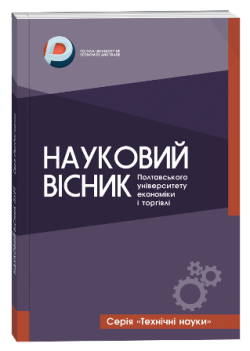STUDY OF QUALITY INDICATORS OF DESSERT BREAD WITH CANDIED VEGETABLES
Abstract
Flour products are the most popular among food consumers. This is due to their high value and relatively low cost. The assortment of dessert types of bread in Ukraine is quite limited and is represented mainly by muffins and Easter cakes. Dried fruits and nuts are usually used as additives in the production of dessert breads. These foods are high in sugar and fat. This composition of dessert bread limits their consumption for the elderly and children. Despite the beneficial properties of vegetables, there are no dessert types of bread enriched with vegetable additives on the consumer market. It is proposed to enrich bread with derivatives of beet (Beta vulgaris), carrot (Daucus), parsnip (Pastináca sativa) and celery (Apium graveolens) processing of root vegetables. Candied vegetables were produced by osmotic dehydration and drying. The content of crude fiber in candied vegetables was studied. It has been established that most of it is contained in candied carrots (2.8%). In addition to candied fruits, osmotic solutions formed after dehydration of carrot roots were introduced into the recipe for dessert bread. This made it possible to exclude sugar and water from the bread recipe. The sponge method was used to produce prototypes of dessert bread with the same amount of candied vegetables of each type. According to the mass fraction of moisture and acidity, the prototype bread samples corresponded to the normative indicators. At the same time, it was possible to reduce the mass fraction of total sugar by 7%. It was also possible to reduce the mass fraction of fat in the finished product by 6.7%. Despite these results, the dessert bread enriched with candied fruit had a pleasant sweet taste and yellow flesh color. The resulting product received a high organoleptic evaluation. The use of candied fruits and osmotic solutions for bread enrichment will allow not only expanding the range of craft products, but also obtaining a product with better functional properties that can be consumed by people of all ages.
References
2. Шаніна О. М., Галясний І. В., Лобачова Н. Л. Обґрунтування складу борошняної сировини в технології безглютенового бездріжджового хліба. Wschodnioeuropejskie Czasopismo Naukowe. 2015. Vol. 4. № 2. P. 56-60.
3. Кожевнікова В.О. Удосконалення технології хлібобулочних виробів з використанням лікарської та пряно-ароматичної сировини : автореф. дис. … канд. техн. Наук : 05.18.01- технологія хлібопекарських продуктів та харчових концентратів. Одеса: Одеська національна академія харчових технологій. 2016. 23 с.
4. Obiegbuna J. Effect of substituting sugar with date palm pulp meal on the physicochemical, organoleptic and storage properties of bread. African Journal of Food Science. 2013. 7(6). рр.113-119. DOI:10.5897/AJFS2012.0605.
5. Pathak D., Majumdar J., Raychaudhuri U., Chakraborty R. Study on enrichment of whole wheat bread quality with the incorporation of tropical fruit by-product. International Food Research Journal. 2017. 24(1). рр. 238-246.
6. Семенюк Д., Кострова І. Нове в технології хліба. Зерно і хліб. 2004. № 9. С. 38.
7. Лисюк Г., Фоміна І. Ядро насіння соняшнику. Хлібопекарська і кондитерська промисловість України. 2005. № 6. С. 18-19.
8. Салухіна Н.Г., Мамоцленко А.А., Ващенко В.В. Товарознавство зерноборошняних товарів: підручник. Київ: КДТЕУ. 2012. 313 с.
9. Козлов Г., Карабіна П. Часник як добавка для хлібобулочних виробів. Хлібопекарська і кондитерська промисловість України. 2005. № 8. С. 26.
10. Снєжкін Ю., Петрова Ж. Порошки з овочів і фруктів. Зерно і хліб. 2004. № 7. С. 38.
11. Жестерєва Н., Грегірчак Н. Рослинні порошки в хлібі використовувати доцільно. Зерно і хліб. 2005. № 11. С. 42.
12. Пахомська О.В. Науковий підхід до створення хлібобулочних виробів функціонального призначення. Харчові технології. 2019. Том 25, № 2. С. 276-283. DOI: 10.24263/2225-2924-2019-25-2-30.
13. Самілик М.М. Теоретичні та практичні передумови вибору осмотичної дегідратації для переробки рослинної сировини: монографія. Сумськ. нац. аграр. ун-т. Одеса: Астропринт. 2023.100 с. ISBN 978–966–927–894–4.
14. Tappi S., Tylewicz U., Dalla Rosa M. Effect of nonthermal technologies on functional food compounds, In: Sustainability of the food system sovereignty, waste, and nutrients bioavailability. Elsevier Inc. 2020. pp. 147–165, DOI: 10.1016/B978-0-12-818293-2.00008-2.


